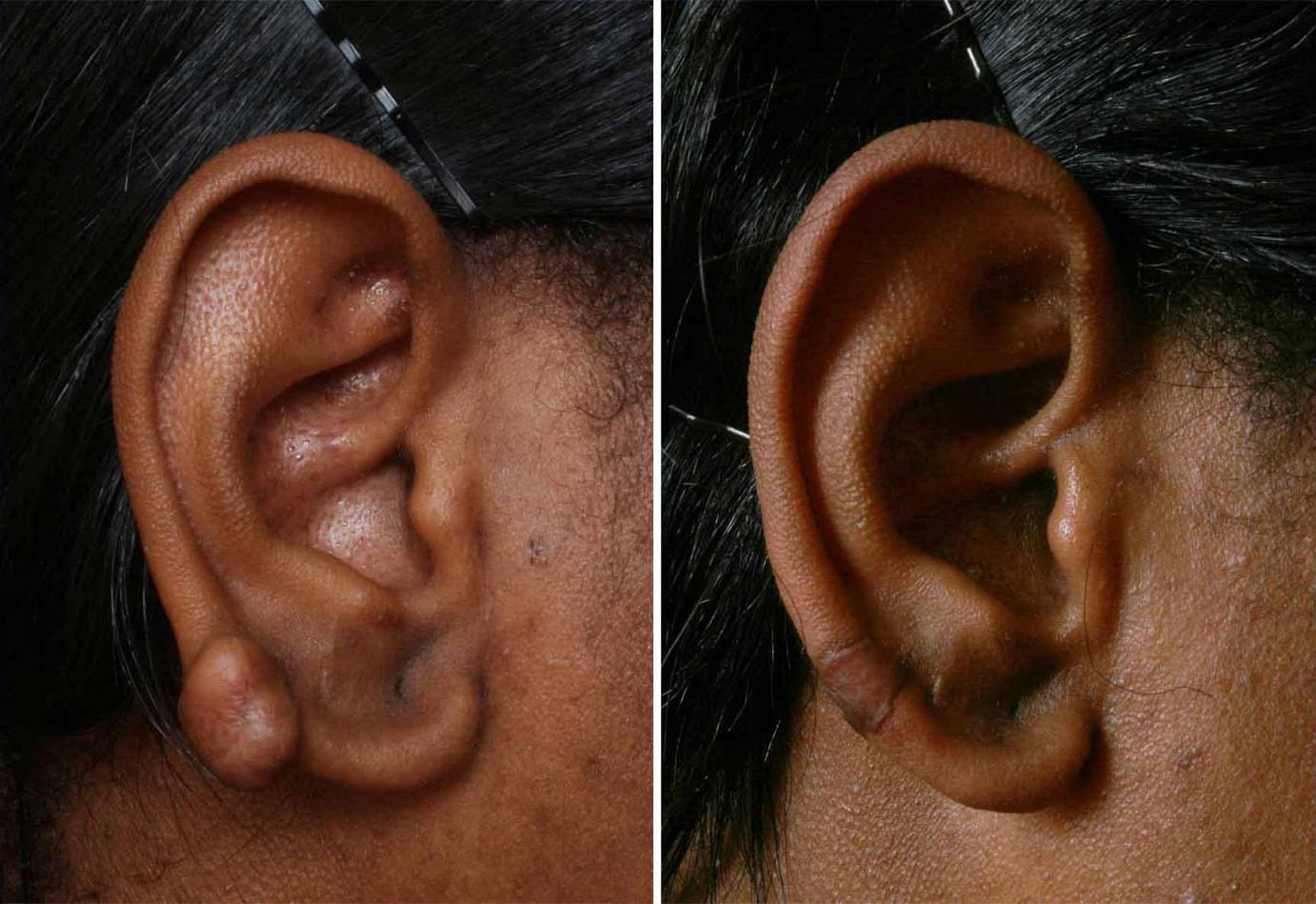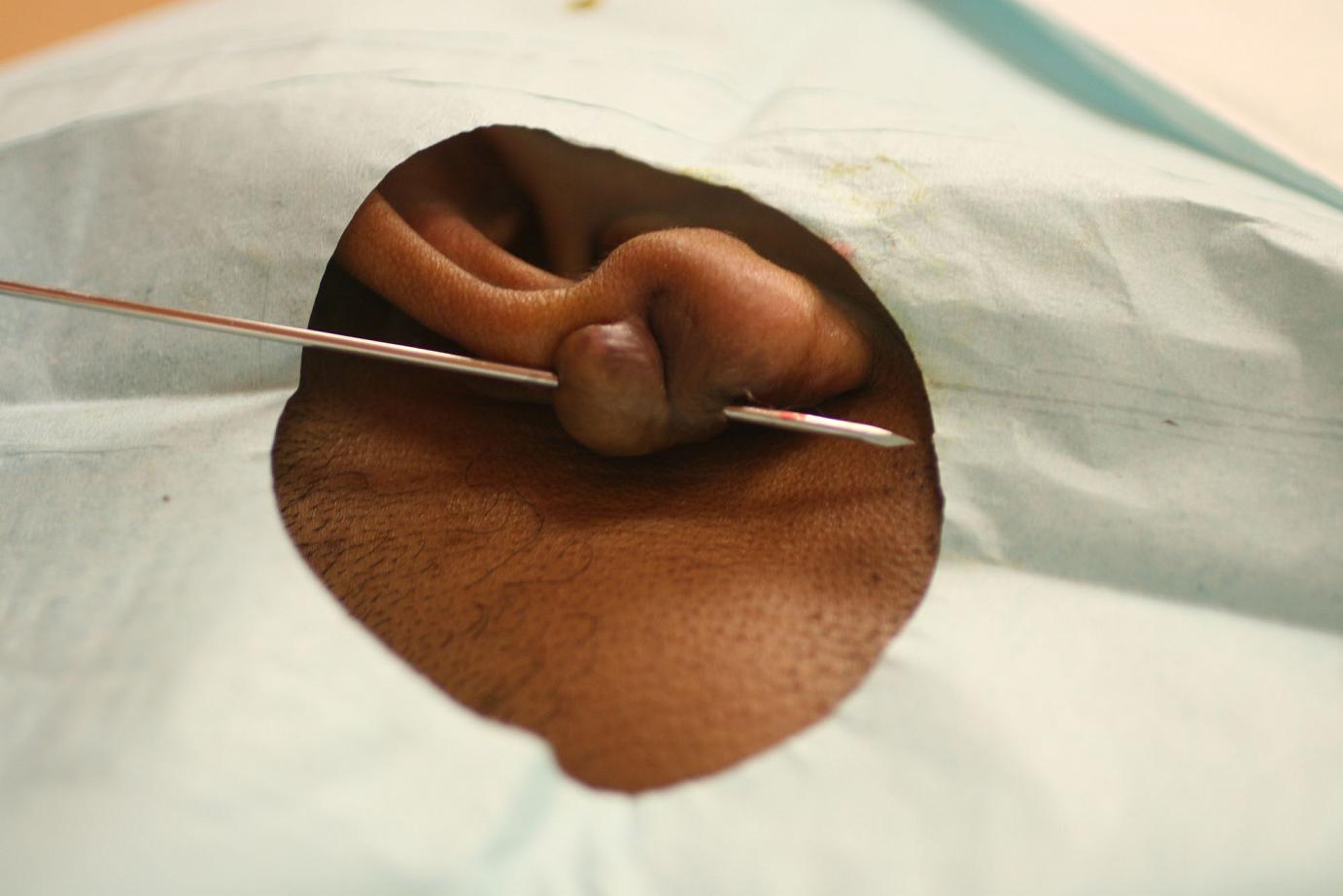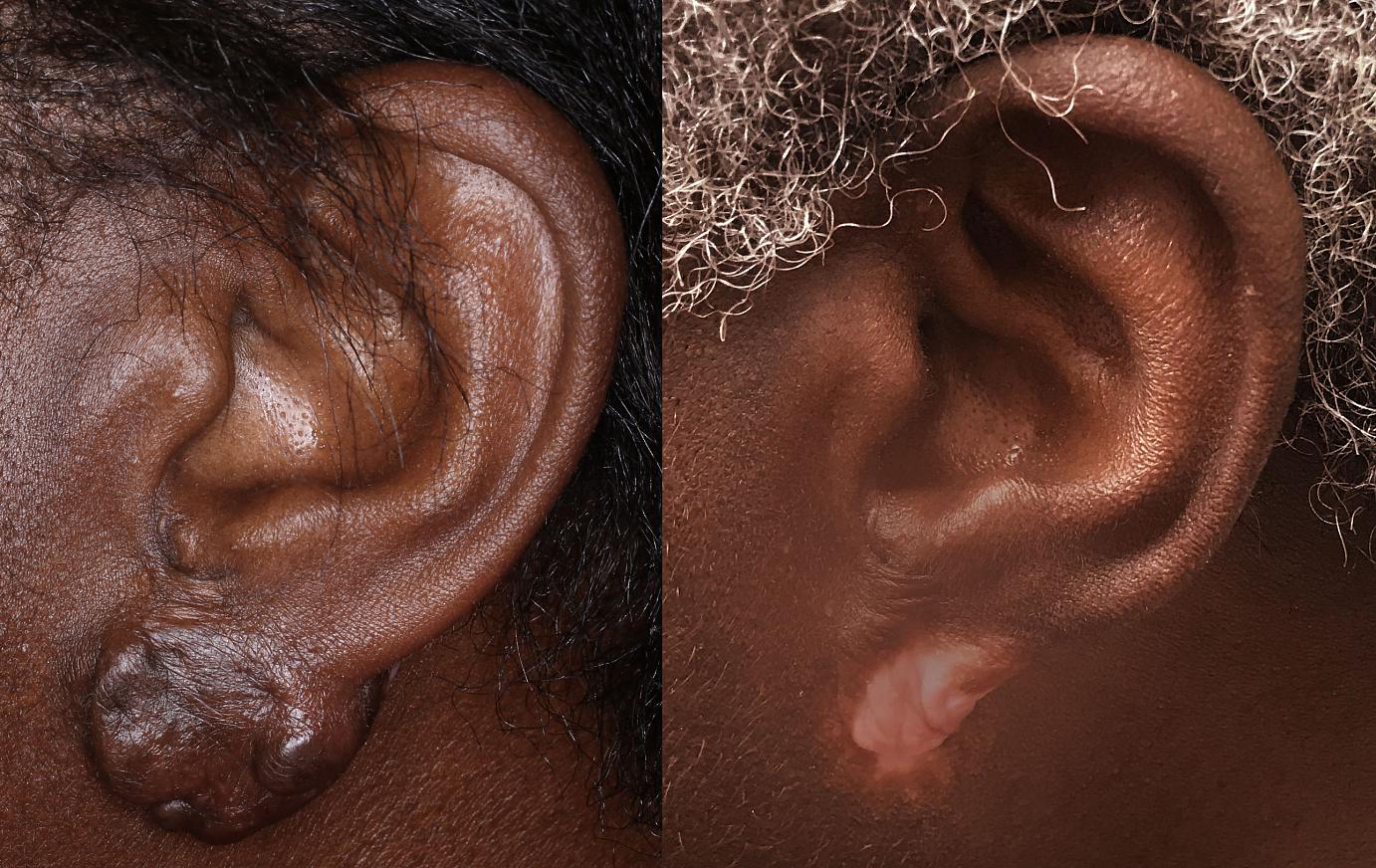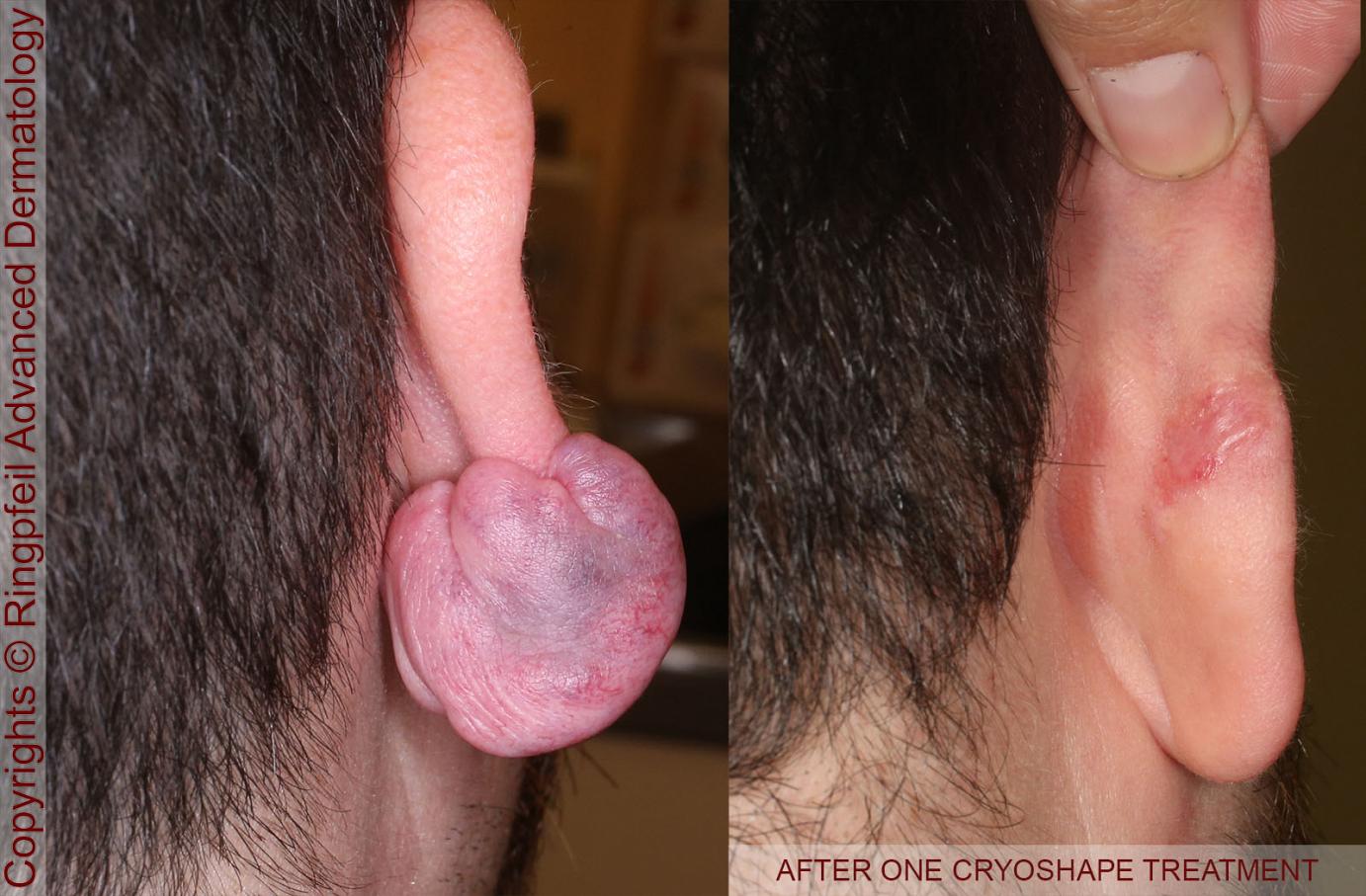Keloids - Patients ask, Dr. Ringpfeil answers
Please feel free to use the blog below to share information about Keloids or to ask Dr. Franziska Ringpfeil a question that might be of interest to others.

A keloid is a type of scar that occurs spontaneously. Keloids may be hereditary and are commonly formed on areas such as the frontal midline of the body. People of Mediterranean or African descent are at higher risk of developing keloids. In our office, the treatment options for active keloids include intralesional Kenalog, intralesional Kenalog combined with 5-fluorouracil, pulsed dye laser (PDL) treatments, and CryoShape™.
Keloids may become itchy and tender, with the degree of pain varying from person to person. Intralesional steroid injections are recommended into firm keloids to treat symptoms and to reduce these keloids. Pulsed dye laser treatments help reduce acute inflammation and further soften the keloid. The CryoShape™ procedure utilizes a probe to freeze and destroy the scar tissue on the inside of a keloid with minimal discomfort and no pigment changes to the surrounding skin. This treatment is most appropriate for larger keloids that have been unresponsive to steroid injections.
"Keloid disease does not yet have a cure and the phrase ‘permanent removal’ is therefore unfitting. In any area where a keloid had once been, a new keloid could form with significant trauma at any time.
Surgical removal of keloid results in recurrence about 85% of the time and sightly less if immediately followed by 4 days of radiation or weekly steroid injections x 4. Only keloids on the ear have a lesser recurrence rate because there is no movement beneath the healing skin in the post operative period of 3 months. Of the recurrent keloids, 14% will be bigger than the previous one.
Your next best step might be Cryoshape or external cryotherapy. Cryoshape works best for keloids that are about the size of a Lima bean. This technique that shrinks about 80% of the keloid from within after one treatment. We have not seen worsening keloids after Cryoshape and they have not been reported. There is a 5% chance that the keloid does not respond to treatment. Keloids that a larger than a Lima bean may require several treatments 4 months apart.
External cryotherapy can shrink keloids that are smaller than a Lima bean. When combined with injections, the results after 4-6 monthly treatments are equal to Cryoshape. It can fail to shrink the keloid about 10% of the time. It is not associated with worsening keloids.
The residual scar after Cryoshape or external cryotherapy is not as smooth as an ideal surgical wound."


Many physicians have performed surgical removal of keloids over the years; however, the likelihood for keloids to recur in surgically treated areas is extremely high and it is expected that any new keloid that forms is much bigger than the original one. If a keloid responds very well to corticosteroids but does not entirely flatten, surgery may be attempted if desired by the patient. Steroid injections must be performed at the time of surgery and every 2 weeks thereafter to prevent keloid formation at the site of surgical trauma. Usually, 3 injections after surgery are required to minimize the risk of keloid formation.
Keloids that do not respond to corticosteroids or are too big for meaningful injection may benefit from excision with subsequent radiation. If this is the case, we will refer you to a specialist that offers both treatments.

I once had a genital piercing that has left me with what I believe is either a keloid or a hypertonic scar, which I would like removed. What are my options and how much are the costs? Any information would be greatly appreciated!
Hypertrophic scars and keloids are very different in their biologic behavior. Both cannot be removed without trace but both can often be injected with a steroid and will reduce significantly or may resolve to a flat scar. There are circumstances under which scar revision by excision for a hypertrophic scar may be preferred, especially when the expected scar is minimal. However, the chance of another keloid developing, when an existing keloid is excised, is about 90%, and therefore excision is usually not an alternative. If several steroid injections soften a keloid without flattening it, shave excision may be attempted with additional steroid injections at time of excision, as well 2 and 4 weeks after to minimize the risk of a returning keloid. In very rare instances, when a keloid does not respond to steroid injections or is so large that it cannot be injected, radiation may be necessary.
Cost of the procedure depends on the size of the lesion. We typically charge $50 per injection and anywhere between 1-3 may be needed for hypertrophic scars and between 2-10 treatments for keloids. Revision of hypertrophic scars by complete excision ranges between $150 (up to 5 mm) and $400 (over 4 mm). Shave removal of keloids may range between $130 (up to 5 mm) and $230 (over 2 cm). Three steroid injections needed after shave removal are charged in addition to the shave removal as mentioned above.
Radiation is not a service that our office performs because it is rarely needed.
While the revision of hypertrophic scars is not always an insurance covered service, most insurances cover the treatment of keloids.
I have a long keloid going straight down my stomach and two on my arm from surgery can they be treated and what procedure would be best for me
They may be flattened by injections, laser or internal cryosurgery
(cryoshape) depending on size, color shape and your skin color. The abdomen and arms are usually poor sites for surgical revision.
i was wondering how much it would cost to get two keloids on my ear removed..they are about the size of a nickel. also you dont accept my insurance but i was wondering how much it would be as far as a consultation. anyway i am really lookin to get them removed so any information would be great
Our fee for localized examination and consultation for keloids is $115. The likelihood for keloids to recur after surgical removal is extremely high and it is expected that any new keloid is much bigger than the original one.
Therefore, intralesional steroid injections are recommended into firm keloids to treat symptoms and to reduce these keloids. If keloids soften or shrink but do not completely flatten after a series of 3 intralesional steroid injections, surgery may be attempted. Steroid injections must also be performed at time of surgery and every 2 weeks thereafter to prevent keloid formation at the site of surgical removal. Usually, 3 injections after surgery are required to minimize the risk for keloid formation.
Keloids that do not respond (soften or flatten) to intralesional steroids may benefit from excision with subsequent radiation.
Franziska Ringpfeil, MD
I have a friend in China who suffers from keloid and wants to come to the USA to get treatment. I am wondering if treatment of keloid is your specialty. If not, could you please recommend a specialist on keloid?
Thanks for your help.
Sincerely,
Z. Gu
Keloids are characterized by uninhibited scar formation. Medical and surgical (including laser) treatment is available and its efficacy and use depends on size and location of the keloid. While I have ample experience in the medical, surgical and laser treatment of keloids, I consider all dermatologists keloid specialists. Our office offers all aspects of keloid treatment.
I have had a keloid on my chest for about 4 years. Every year its increasingly painful and it seems to get bigger. I know treating keloids is very difficult. And I was wondering if there is something that can be done. When it first appeared I had three steroid injections that did nothing. I had another keloid and it was treated by steroid injection and it went away. Any feedback would be beneficial.
As you already mentioned, keloids can be tough to treat. As you may have heard, excision is not usually recommended due to high risk of the keloid recurring with a fear that it could be bigger than before. Injections with steroid or combination of steroid and 5 fluorouracil are currently accepted treatment strategies by most insurances. Additional treatment options (but not usually insurance covered) are a series of pulsed dye laser or CO2 laser treatments. Evaluation of the keloid is necessary to determine the best option for you.
I have what you might call a medical emergency. A cluster of keloids(5) have grown to the size of 50cent peices on my face in my beard area. The skin is being expanded to the point breaks have occurred as well bleeding and a pus like substance drains out of the cracks. What procedure would best help my situation? I have insurance, but what would the cost of beneficial surgical correction be?
What you describe does not only sound like keloids but a severe inflammatory reaction in the hair bearing area. The inflammation should be diagnosed, brought under control quickly to avoid further keloid formation and only when quiet should keloid treatment be considered.
I currently have a keloid on my right ear the size of a quarter, that i would likes removed. I previously had surgery and and this is the end result. I was wondering if you offer Cryosurgery and if so what the cost would be without insurance. I also received steroid injections also.
Cryosurgery may be attempted to minimize a keloid but it is not a very efficient treatment modality for keloids. The cost per treatment in our office is $100 without insurance for the size of your keloid. Other treatment options include another excision ($230) followed by 3 post operative steroid injections ($50 each). The first injection is done immediately after surgery provided that your keloid has previously softened with steroid injections.
I had a small keloid on the center of my chest and this doctor who was an expert in removing them told me “Oh yeah removing it would be your best option & lets follow that up with 3 treatments of radiation to ensure that that won’t return”. She LIED to me because what she didn’t tell me was that there was an even greater chance of it coming back and even larger than my original keloid. Now I have this nasty looking thing on my chest that is SO PAINFUL and consumes my everyday living. It burns me up how some doctors tell you what ever they want just to make a Buck!! Even with the steriod injections I have been getting for the past three months I still have no relief. My belief is that if you have a keliod , just get use to the fact that it will be with you until the day you die. there is no escaping the pain, the scar, the uncomfortable feeling you get when you look at yourself in the mirrior. No doctor will ever be able to fix that!!!!!
I am sorry to hear about your experience. Keloids are one of nature’s happenings that are very difficult to treat. Excision without after-treatment by injections or radiation is almost never recommended but even these modalities can fail as you have experienced. Steroid or 5 fluorouracil injections can alleviate pain and can shrink keloids. While I do not know your dermatologist, I cannot imagine that she recommended excision followed by radiation to cause an even bigger keloid. However, I do appreciate very much that you are sharing your experience and I hope that there will eventually be something that can control your pain.
I have a keloid on my ear right where the cartledge is from a piercing, I wanted to know if that can be removed and about how much would it cost, my insurance will not cover it being as though its considered cosmetic! Can you guys help me please?!
Excision of a keloid is never simple but on the ear it may be possible. Cost depends on size of keloid. Up to 3 steroid injections should be performed before and another three after surgery. Cost for removal of a keloid that measures up to 1 cm and allows simple shave excision, including injections, may start at $460. This fee does not include the initial consultation, which will be submitted to the insurance.
I have a keloid in my left ear that isnt painful its just really gross looking
Its from a piercing i got a few years back, im just curious about the process
I would have to take to get it removed supposedly the injections only flatten but
I would like it removed around what price range would it be to get that done?!
The cost of removal depends on the size of your keloid. Injections in ear keloids are usually performed before the surgery to assess the efficacy of steroid to suppress keloid formation after any type of surgery. If your keloid on the earlobe softens in response to steroid injections, removal can be recommended and steroid injections will be performed after the procedure if needed to avoid post traumatic keloid formation. If a keloid does not soften with steroid injections, removal may not be recommended because a new keloid after surgery is usually much bigger than the original keloid.
I have keloids on both sides of my face on my jawline. I’ve seen over 10 dermatologist and have had about 15 steroid shots but no improvement at all. My question is, in conjunction with the shots, is there anything else that could be used to help shrink the keloids? This is killing my confidence.
10+ dermatologists should give a reasonable perspective. Keloids are difficult to treat in general and depending on their position and shape, are sometimes limited in treatment options. It is however surprising that you had 15 injections when you have seen 10+ dermatologists. It implies that there has not been one main dermatologist treating your keloids. Keloids take many injections to flatten and the concentration of steroid, which in certain locations of the body can be mixed with 5 fluorouracil, is important. Sometimes laser treatments can be used to speed up the treatment but care must be taken not to change your natural pigment.